Gaza aid convoy strike: What we know
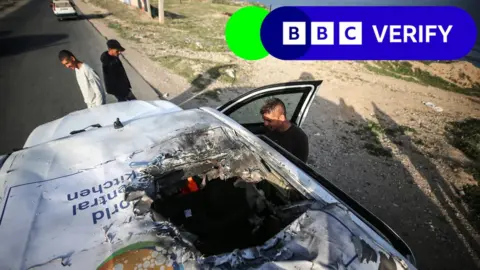 Getty Images
Getty ImagesThe Israeli military has released the findings of its investigation into its attack on a convoy in Gaza which killed seven aid workers.
The Israeli Defense Forces (IDF) say the vehicles were hit by missiles after its drone operators mistakenly thought they were carrying Hamas gunmen. The IDF says it has dismissed two senior military officers and reprimanded two others.
Since the attack on 1 April, BBC Verify has been studying images of its aftermath, shared on social media, to try to piece together what we know about the incident.
The convoy
The group of World Central Kitchen (WCK) aid workers were travelling in three cars - two of them armoured.
They were part of a convoy delivering more than 100 tonnes of food supplies from a recently constructed pier to a warehouse in Deir al-Balah in central Gaza, according to WCK.
It says their movements had been co-ordinated with the IDF in advance but the investigation has found that this information had not been shared with Israeli drone operators tracking the convoy.
The IDF says they had spotted a gunman riding on the roof of a large aid lorry, that was being escorted by the WCK team. Drone footage of this was shown to journalists at an IDF briefing on 4 April but has not been released.
The IDF says the convoy was tracked to a warehouse (labelled 'A' on the map) where the aid lorry remained and four "SUV-type cars" emerged. It says one contained gunmen - also shown to journalists in drone footage - and headed north but was not targeted because it was close to another aid facility (labelled 'B').
The three remaining vehicles, belonging to WCK, headed south.
The investigation says "one of the commanders mistakenly assumed that gunmen were inside the accompanying vehicles and that these were Hamas terrorists".
The drone operators, the IDF says, had "misidentified" one of the aid workers as a gunman - they thought he was carrying a gun when he entered one of the cars but he was holding a bag. The IDF has not shown this footage.
The cars were then targeted.
The strike
Images of the three badly damaged vehicles emerged on social media and have been analysed by BBC Verify to work out where they were struck.
They were located along a stretch of road and were 2.5km (1.5 miles) apart, which suggests there was more than one strike. The IDF report confirms this. It says the first vehicle was struck at 2309, the second at 2311 and the third at 2313.

The WCK head Jose Andres says those in the convoy had tried to call the IDF during the attack.
"They were targeted systemically car by car. They attacked the first car. They were able to move in the second one. Again this one was hit. They were able to move in (into) the third one."
"It was a direct hit. They tried to treat some of them and put them in another car in front. But they shelled the car," said a local resident, who said he had witnessed the strike.
BBC Verify pinpointed the locations of the strikes by matching visual clues in the photos of the vehicles with satellite images of this part of Gaza.
In one image of a heavily damaged Toyota Hilux, as well as the trees and fence beside the vehicle, a lone palm tree stands in a walled enclosure with a distinctive pattern of buildings surrounding it.
Using satellite images, these features have been matched with a part of Al-Rashid road - which runs along the coast in central Gaza.
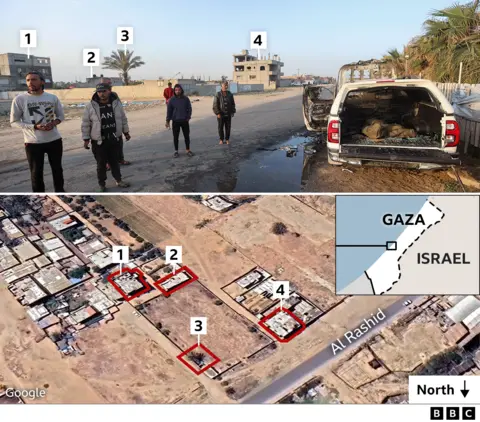
A second vehicle was pictured with a WCK logo on its roof and a large hole in it. A pylon, a section of woodland, a low wall and two distinct roofs can be seen in the background. BBC Verify matched the scene to about 800m south of the first vehicle.
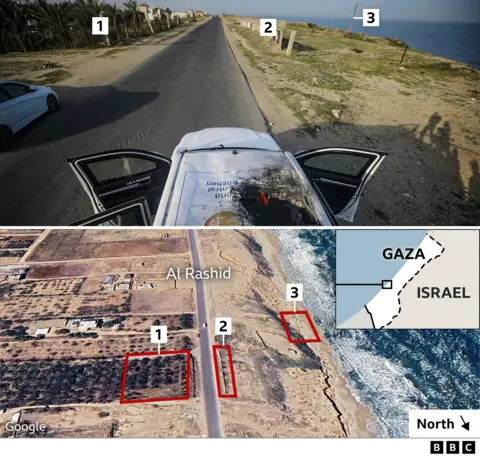
A third damaged vehicle was photographed in an area of open ground to the south, about 100m off the road.The WCK says this third car was a "soft-skin vehicle" - meaning not armoured. It was about 1.6km south of the second vehicle and 2.5km of the first.
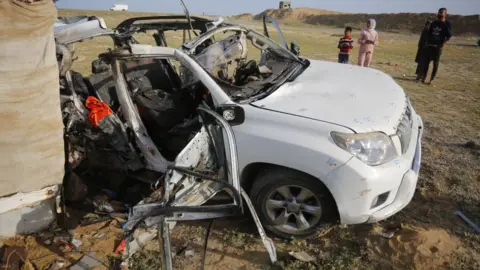 Getty Images
Getty ImagesWhat weapons were used?
The IDF says drone-fired missiles were used in the attack.
This confirms the initial analysis from military experts who we sent images of the vehicles to on 2 April.
Chris Cobb-Smith, a former British Army officer and ex-UN weapons inspector, told us the attack was probably the result of drone-launched Spike missiles.
Spike missiles are a type of powerful weapon, usually launched against tanks and other armoured vehicles.
Justin Crump, a former British Army officer who runs Sibylline - a risk intelligence company - agreed that the attack "was likely drone-launched and targeted".
The IDF said that the WCK logo - on top of one of the vehicles - was not visible at night to the drone operator. Footage shown at the IDF briefing appeared to confirm this, according to a BBC journalist who attended it.
"The nature of the logos and markings visible on the vehicles, while colourful and suitable for daytime recognition, would appear to stand out much less obviously at night depending on the exact nature of the system used", Mr Crump told us.
WCK had already shared the coordinates and journey details of the aid convoy with the Israeli military.
The victims
The seven aid workers killed were named by WCK as:
- Lalzawmi "Zomi" Frankcom, 43, an Australian citizen
- Damian Sobol, 35, a Polish citizen
- Saifeddin Issam Ayad Abutaha, 25, a Palestinian
- Jacob Flickinger, 33, a dual US-Canadian national
- John Chapman, 57, a British citizen
- James (Jim) Henderson, 33, a British citizen
- James Kirby, 47, a British citizen
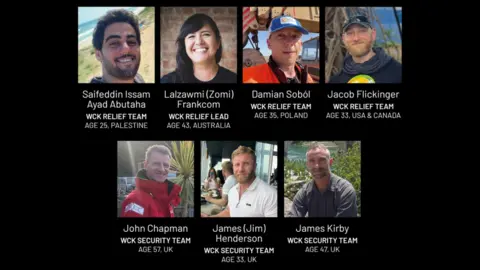 World Central Kitchen
World Central KitchenImages of the aid workers' bodies were first posted on social media just before 22:30 BST on 1 April.
Graphic videos showed the bodies of five individuals. Two more bodies were recovered from Deir al-Balah later on, the Palestine Red Crescent Society said on X.
WCK logos were visible on bulletproof vests on at least three of the deceased.
Videos also showed colleagues from WCK identifying the bodies.
"These are the people who brought the aid from the sea," one said, before crying out as he recognised a Palestinian aid worker killed.
Additional reporting by Merlyn Thomas, Osob Elmi and Joshua Cheetham.
This article, originally published on 2 April, has been updated to reflect the findings of the IDF investigation. We have asked the IDF to release its drone footage of the incident.




